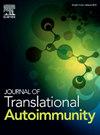A laboratory test to detect gliadin-specific CD4+ T-cells for difficult to diagnose celiac disease
IF 3.6
Q2 IMMUNOLOGY
引用次数: 0
Abstract
Objectives
Discrepancy between serology and small bowel histology, such as seronegative CD, poses a diagnostic challenge in celiac disease (CD) diagnosis. Recently described methods to detect gliadin-specific T-cells are too laborious even in a specialized diagnostic setting. We developed a method, which can be implemented in specialized diagnostic laboratories.
Methods
Gliadin-specific T-cells were analyzed by α1-and α2-gliadin peptide loaded Dextramers (Dm) in healthy controls (HC, n = 18), patients with non-celiac gluten sensitivity (NCGS, n = 9), active CD (aCD, n = 7) and CD on a gluten free diet (GFD, n = 14). Control peptide (CLIP)-loaded Dm were used as background controls. The α-gliadin-Dm:CLIP-Dm ratio was calculated. In CD patients ≥5 years on GFD (n = 8), a randomized two-dose gluten challenge was performed to increase gliadin-specific T-cell frequencies.
Results
Gliadin-specific CD4+ T-cell frequencies were significantly higher in aCD and GFD than in HC and NCGS (p ≤ 0.0001). In CD patients on a GFD ≥5 years, gliadin-specific T-cells were detectable in 6/8 patients after a week gluten challenge, and all tested positive within 4 weeks. Gliadin-specific T-cells significantly upregulated CD38 after 1 week of gluten ingestion (p < 0.008). Real world data from sixteen patients demonstrated the applicability of this test in diagnostic challenging cases.
Conclusions
Gliadin-specific T-cells can be detected in peripheral blood of CD patients using commercially available dextramers. These cells persist in CD patients on a GFD but may decline over time. A short term low-dose gluten challenge increased sensitivity. This simplified detection method of gliadin-specific T-cells is suitable for diagnostic challenging CD cases.
一项检测麦胶蛋白特异性CD4+ t细胞的实验室试验难以诊断乳糜泻
目的血清学与小肠组织学的差异,如血清乳糜泻阴性,对乳糜泻的诊断提出了挑战。最近描述的检测麦胶蛋白特异性t细胞的方法即使在专门的诊断设置中也过于费力。我们开发了一种方法,可以在专门的诊断实验室实施。方法采用α1和α2麦胶蛋白肽负载葡聚糖(Dm)对健康对照组(HC, n = 18)、非乳糜泻谷蛋白敏感患者(NCGS, n = 9)、活性乳糜泻患者(aCD, n = 7)和无麸质饮食的乳糜泻患者(GFD, n = 14)的麦胶蛋白特异性t细胞进行分析。对照肽(CLIP)加载Dm作为背景对照。计算α-麦胶蛋白- dm:CLIP-Dm比值。在接受GFD治疗≥5年的CD患者中(n = 8),进行随机双剂量谷蛋白刺激以增加麦胶蛋白特异性t细胞频率。结果aCD和GFD的gliadin特异性CD4+ t细胞频率显著高于HC和NCGS (p≤0.0001)。在GFD≥5年的CD患者中,6/8的患者在一周的麸质攻击后检测到麦胶蛋白特异性t细胞,并且在4周内全部检测出阳性。麦胶蛋白特异性t细胞在摄入谷蛋白1周后显著上调CD38 (p <;0.008)。来自16名患者的真实世界数据证明了该测试在诊断挑战性病例中的适用性。结论市售右旋聚物可在CD患者外周血中检测到麦胶蛋白特异性t细胞。这些细胞在患有GFD的乳糜泻患者体内持续存在,但可能随着时间的推移而减少。短期低剂量谷蛋白刺激会增加敏感性。这种简化的麦胶蛋白特异性t细胞检测方法适用于诊断挑战性CD病例。
本文章由计算机程序翻译,如有差异,请以英文原文为准。
求助全文
约1分钟内获得全文
求助全文
来源期刊

Journal of Translational Autoimmunity
Medicine-Immunology and Allergy
CiteScore
7.80
自引率
2.60%
发文量
33
审稿时长
55 days
 求助内容:
求助内容: 应助结果提醒方式:
应助结果提醒方式:


